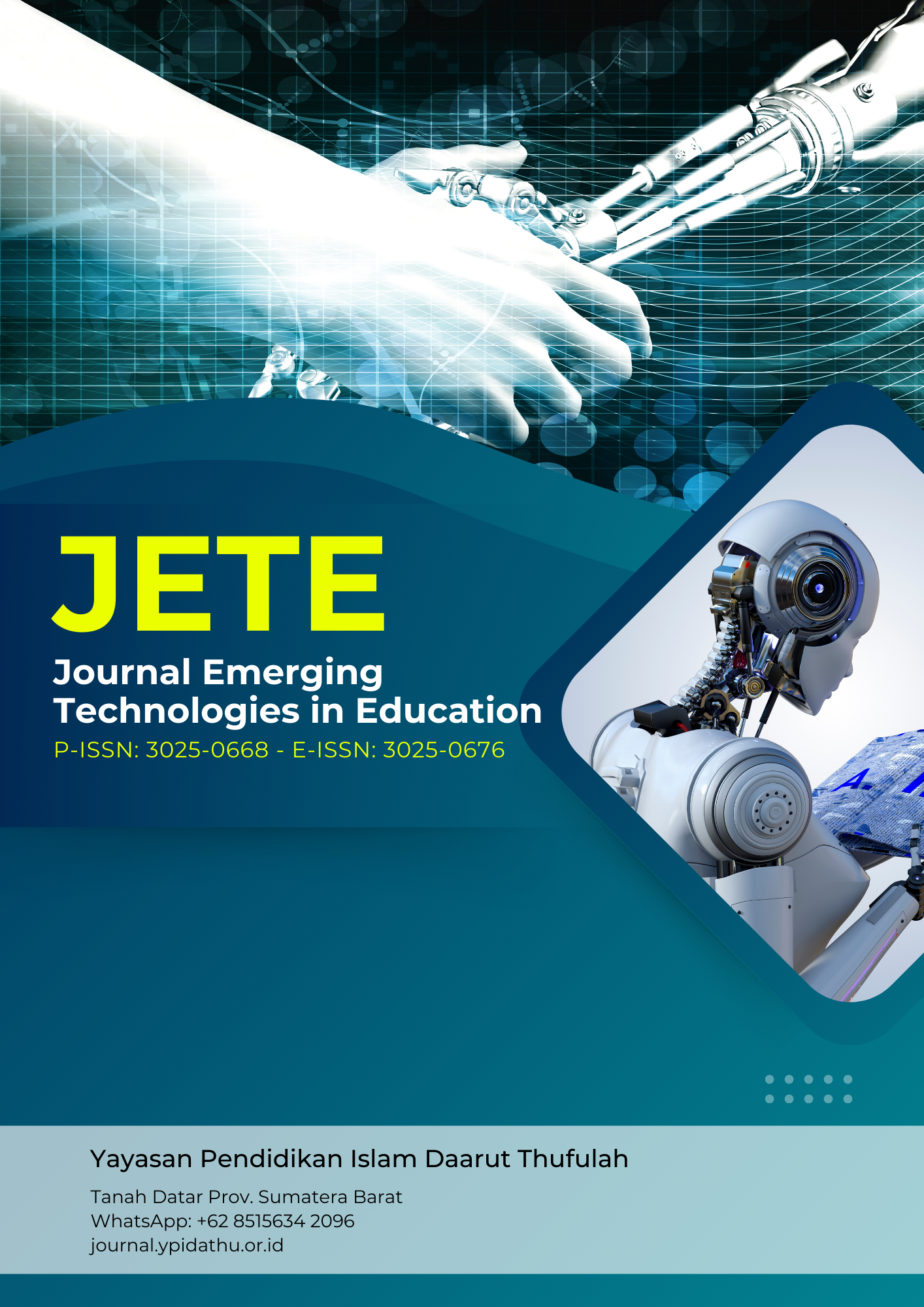Influence of the Blended Learning Method on Student Achievement in Mathematics Lessons
Abstract
Background. The characteristics and achievements of each student are different. This is influenced by the methods, interests, talents, media, sources, environment, and even strategies of the students themselves. A blanded learning method that combines traditional classroom learning with online-based learning can make a big impact in the world of education. It will provide opportunities for students to learn with more flexibility. It also creates a more engaging learning experience.
Purpose This study aims to find out how much the use of blended learning method affects students' achievement. This achievement is more specific to mathematics learning. This is because there are often difficulties in understanding mathematics learning by students. Therefore, the blended learning method is considered to be able to influence learning, especially mathematics.
Method. The method used in this research is quantitative. This method is considered suitable as a measuring tool. This is because the effect of using the blanded learning method on student achievement can be measured by a number scale. So that it can be read or understood through graphs, percentages, or data processing. Research using quantitative methods that have the characteristics of using numbers will be more in line with this research.
Results. The result of this study explains that the use of blanded learning method will affect students' achievement in learning mathematics. The blanded learning method that combines traditional and online-based learning will enrich the learning experience. Not only that, this method will also provide a combination of different methods, media, sources, environments, and even learning strategies.
Conclusion This research can be concluded that the use of blanded learning method will provide innovation in learning. It will support different ways of learning from students. In addition, it will also help teachers in the flexibility of organising learning time. On the other hand, it will also help students who have difficulty in following face-to-face learning.
Full text article
References
Awamleh, A. A. (2020). Students satisfaction on blended learning in school of sport sciences. Annals of Applied Sport Science, 8(1). https://doi.org/10.29252/AASSJOURNAL.803
Deng, C. (2022). Research on the state of blended learning among college students – A mixed-method approach. Frontiers in Psychology, 13(Query date: 2024-04-10 04:17:28). https://doi.org/10.3389/fpsyg.2022.1054137
Dermawan, O. (2023). The influence of STEM-based blended learning model assisted by schoology on critical thinking skills. AIP Conference Proceedings, 2595(Query date: 2024-04-10 04:17:28). https://doi.org/10.1063/5.0123682
Guibin, Y. (2021). Research on the influence of Student Role Stress on Learning Satisfaction in Blended Learning Based on SPSS21.0 and Amos24.0. Proceedings - 2021 2nd International Conference on Education, Knowledge and Information Management, ICEKIM 2021, Query date: 2024-04-10 04:17:28, 167–174. https://doi.org/10.1109/ICEKIM52309.2021.00044
Ihnatova, O. (2022). THE EFFECTIVENESS OF BLENDED LEARNING IN ENGLISH TEACHER TRAINING. Journal of Teaching English for Specific and Academic Purposes, 10(3), 377–388. https://doi.org/10.22190/JTESAP2203377I
Jia, W. (2021). UHPLC-Q-Orbitrap HRMS-based quantitative lipidomics reveals the chemical changes of phospholipids during thermal processing methods of Tan sheep meat. Food Chemistry, 360(Query date: 2024-02-10 03:38:39). https://doi.org/10.1016/j.foodchem.2021.130153
Johnson, J. M. (2019). Survey on deep learning with class imbalance. Journal of Big Data, 6(1). https://doi.org/10.1186/s40537-019-0192-5
Khosla, P. (2020). Supervised contrastive learning. Advances in Neural Information Processing Systems, 2020(Query date: 2024-04-10 11:47:38). https://api.elsevier.com/content/abstract/scopus_id/85108420032
Lavery, J. (2018). The research Fairness initiative: Filling a critical gap in global research ethics. Gates Open Research, 2(Query date: 2023-10-24 14:07:30). https://doi.org/10.12688/gatesopenres.12884.1
Lu, D. N. (2020). The factors affecting acceptance of e-learning: A machine learning algorithm approach. Education Sciences, 10(10), 1–13. https://doi.org/10.3390/educsci10100270
Moghavvemi, S. (2023). Technology Usage and Students Performance: The Influence of Blended Learning. Communications in Computer and Information Science, 1916(Query date: 2024-04-10 04:17:28), 237–253. https://doi.org/10.1007/978-3-031-44581-1_17
Mtshali, M. A. (2020). Online discussion forum: A tool to support learning in business management education. South African Journal of Education, 40(2), 1–9. https://doi.org/10.15700/saje.v40n2a1803
Padmadewi, N. N. (2022). Needs Analysis of Literacy Assessment Using Blended Learning for Beginner EFL Learners. Journal of Language Teaching and Research, 13(2), 441–452. https://doi.org/10.17507/jltr.1302.27
Panyajamorn, T. (2022). USING MOOC AND GAMIFICATION HYBRID LEARNING MODELS IN RURAL PUBLIC SCHOOLS IN THAILAND. Journal of Educators Online, 19(3), 206–223. https://doi.org/10.9743/JEO.2022.19.3.12
Putra, A. K. (2021). The effect of blended project-based learning with stem approach to spatial thinking ability and geographic skill. International Journal of Instruction, 14(3), 685–704. https://doi.org/10.29333/iji.2021.14340a
Saibaba, C. M. H. (2022). Prediction of Public Mental Health by using Machine Learning Algorithms. Proceedings of the 2nd International Conference on Artificial Intelligence and Smart Energy, ICAIS 2022, Query date: 2024-04-10 04:17:28, 308–311. https://doi.org/10.1109/ICAIS53314.2022.9742837
Thompson, P. (2018). The roles of ethics in gene drive research and governance. Journal of Responsible Innovation, 5(Query date: 2023-10-24 14:07:30). https://doi.org/10.1080/23299460.2017.1415587
Vo, T. H. L. (2022). Online simulated workplace tasks to enhance business English learning. Journal of Asian Business and Economic Studies, 29(3), 205–221. https://doi.org/10.1108/JABES-06-2020-0058
Warren, L. (2021). Self-efficacy, performance and the role of blended learning. Journal of Applied Research in Higher Education, 13(1), 98–111. https://doi.org/10.1108/JARHE-08-2019-0210
Wu, C. (2021). Student’s Learning Strategies and Academic Emotions: Their Influence on Learning Satisfaction During the COVID-19 Pandemic. Frontiers in Psychology, 12(Query date: 2024-04-10 04:17:28). https://doi.org/10.3389/fpsyg.2021.717683
Yang, S. (2019). Rotational Blended Learning in Computer System Engineering Courses. IEEE Transactions on Education, 62(4), 264–269. https://doi.org/10.1109/TE.2019.2899095
Authors
Copyright (c) 2024 Baso Intang Sappaile, Dina Mayadiana, Rino Lengam, Xie Guilin, Muhammad Ichsan Abda

This work is licensed under a Creative Commons Attribution-ShareAlike 4.0 International License.





